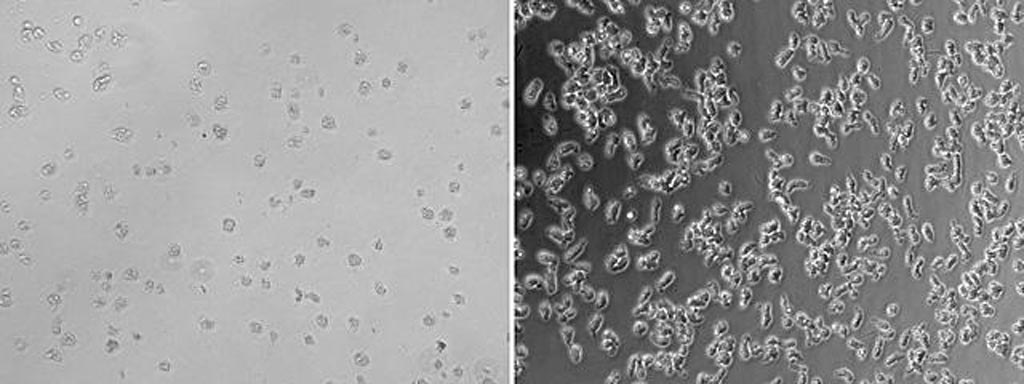Approved Drugs Effectively Suppress Growth of Lethal Pathogen
By LabMedica International staff writers
Posted on 24 Sep 2018
Some currently approved drugs were found to suppress the growth of the amoeba Naegleria fowleri by inhibiting enzymes in the organism's sterol biosynthesis pathway.Posted on 24 Sep 2018
Naegleria fowleri is a free-living amoeba found primarily in warm, under-chlorinated swimming pools, lakes, and rivers that can also act as an opportunistic pathogen causing the severe brain infection, primary amebic meningoencephalitis (PAM), in humans. The high mortality rate of PAM (exceeding 97%) is attributed to (i) delayed diagnosis, (ii) lack of safe and effective anti-N. fowleri drugs, and (iii) difficulty of delivering drugs to the brain.

Image: N. fowleri growth is inhibited with a combination treatment of breast cancer drug tamoxifen and epiminolanosterol (left) as compared to the untreated amoebae (right) (Photo courtesy of the University of California San Diego).
To improve the therapeutic picture for treatment of N. fowleri infection, investigators at the University of California San Diego (USA) sought to identify new molecular targets that could link anti-Naegleria drug discovery to the existing pharmacopeia of brain-penetrant drugs. To this end, they used inhibitors with known mechanism of action as molecular probes to map the sterol biosynthesis pathway of N. fowleri by GC-MS analysis of metabolites.
Results published in the September 13, 2018, online edition of the journal PLoS Pathogens suggested that two enzymes downstream to CYP51 - sterol C24-methyltransferase (SMT, ERG6) and sterol delta8−delta7-isomerase (ERG2) - were potential therapeutic drug targets in N. fowleri. The demethylated products of the CYP51 reaction are vital intermediates in pathways leading to the formation of cholesterol in humans, ergosterol in fungi, and other types of sterols in plants. These sterols localize to the plasma membrane of cells, where they play an important structural role in the regulation of membrane fluidity and permeability and also influence the activity of enzymes, ion channels, and other cell components that are embedded within.
The currently approved drugs tamoxifen and Prozac were found to inhibit the two different enzymes in N. fowleri's sterol biosynthesis pathway. While it required a dose of 54.5 micromolar miltefosine (an investigational drug currently recommended for the treatment of PAM) to arrest the growth of half the amoebae growing in vitro, it only took 5.8 micromolar tamoxifen and 31.8 micromolar Prozac.
"Not many drugs can cross the blood-brain barrier," said senior author Dr. Larissa Podust, associate professor at of pharmacy at the University of California, San Diego. "Even if a drug can inhibit or kill the amoeba in a dish, it will not work in a host animal if it does not make it into the brain. That is why we started with drugs known for their brain effects."
Related Links:
University of California San Diego














